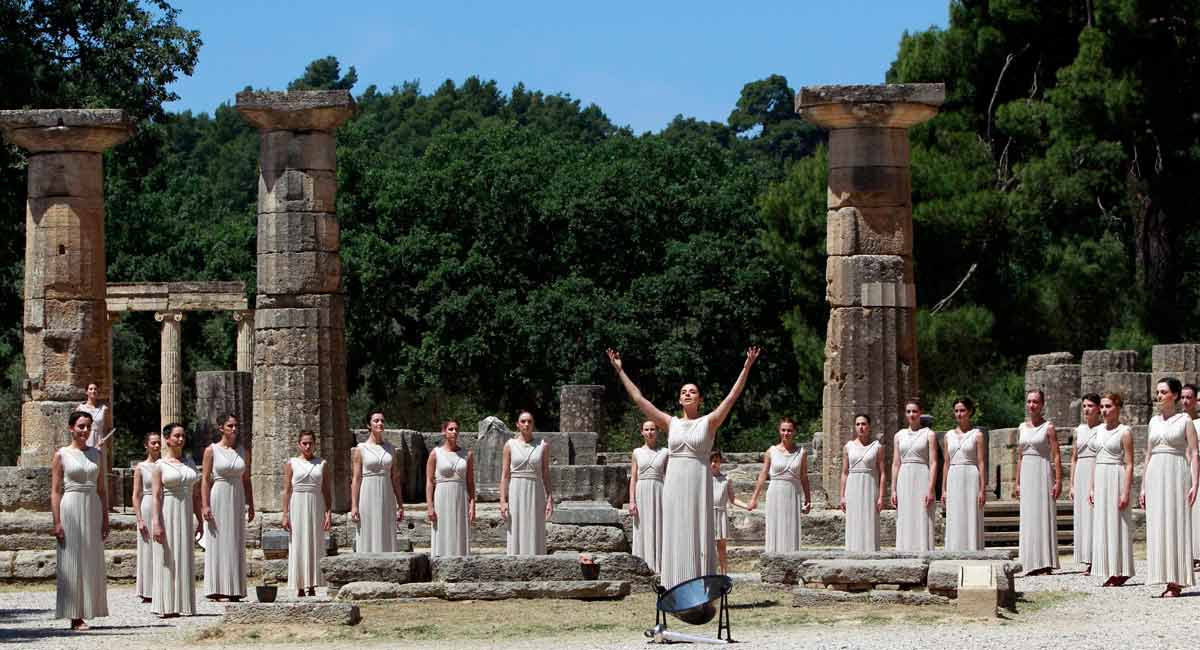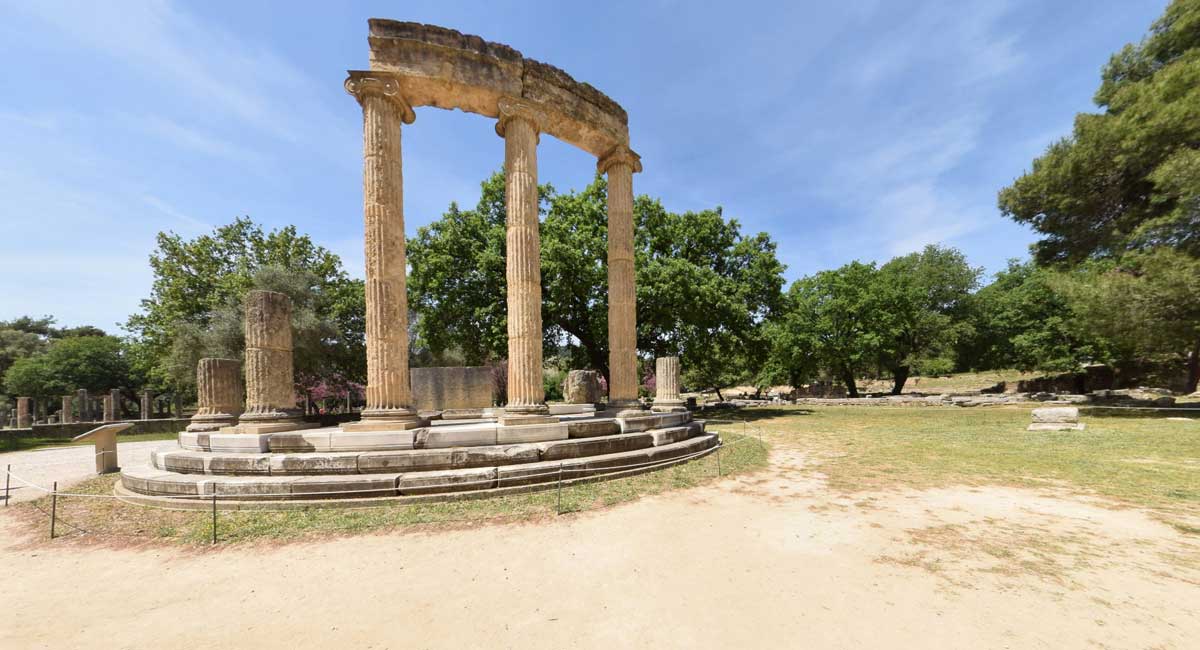ANCIENT OLYMPIA
Olympia a sanctuary of ancient Greece in Elis on the Peloponnese peninsula, is known for having been the site of the Olympic Games in classical times. The Olympic Games were held every four years throughout Classical antiquity, from the 8th century BC to the 4th century AD. The sanctuary, known as the Altis, consists of an unordered arrangement of various buildings. Enclosed within the temenos (sacred enclosure) are the Temple of Hera (or Heraion/Heraeum), the Temple of Zeus, the Pelopion, and the area of the altar, where the sacrifices were made.
To the north of the sanctuary can be found the Prytaneion and the Philippeion, as well as the array of treasuries representing the various city-states. The Metroon lies to the south of these treasuries, with the Echo Stoa to the east. The hippodrome and later stadium were located east of the Echo Stoa. To the south of the sanctuary is the South Stoa and the Bouleuterion, whereas the Palaestra, the workshop of Pheidias, the Gymnasion, and the Leonidaion lie to the west.
Olympia was also known for the gigantic ivory and gold statue of Zeus that used to stand there, sculpted by Pheidias, which was named one of the Seven Wonders of the Ancient World by Antipater of Sidon. Very close to the Temple of Zeus which housed this statue, the studio of Pheidias was excavated in the 1950s. Evidence found there, such as sculptor's tools, corroborates this opinion. The ancient ruins sit north of the Alpheios River and south of Mount Kronos (named after the Greek deity Kronos). The Kladeos, a tributary of the Alpheios, flows around the area.
The first Olympic festival was organized on the site by the authorities of Elis in the 8th century BC – with tradition dating the first games at 776 BC. Major changes were made to the site around 700 BC, including levelling land and digging new wells. Elis' power diminished and the sanctuary fell into the hands of the Pisatans in 676 BC. The Pisatans organized the games until the late 7th century BC.
The earliest evidence of building activity on the site dates from around 600 BC. At this time the Skiloudians, allies of the Pistans, built the Temple of Hera. The Treasuries and the Pelopion were built during the course of the 6th century BC. The secular structures and athletic arenas were also under construction during this period including the Bouleuterion. The first stadium was constructed around 560 BC, it consisted of just a simple track. The stadium was remodelled around 500 BC with sloping sides for spectators and shifted slightly to the east. Over the course of the 6th century BC a range of sports were added to the Olympic festival. In 580 BC, Elis, in alliance with Sparta, occupied Pisa and regained the control over the sanctuary.

The classical period, between the 5th and 4th centuries BC, was the golden age of the site at Olympia. A wide range of new religious and secular buildings and structures were constructed.
The Temple of Zeus was built in the middle of the 5th century BC. Its size, scale and ornamentation was beyond anything previously constructed on the site. Further sporting facilities, including the final iteration of the stadium, and the hippodrome (for chariot-racing) were constructed. The Prytaneion was built at the northwest side of the site in 470 BC.
In the late classical period, further structures were added to the site. The Metroon was constructed near the Treasuries c.400 BC. The erection of the Echo Stoa, around 350 BC, separated off the sanctuary from the area of the games and stadium. The South Stoa was built at the southern edge of the sanctuary at approximately the same time.
The late 4th century BC saw the erection of the Philippeion. Around 300 BC the largest building on the site, the Leonidaion, was constructed to house important visitors. Due to the increasing importance of the games, further athletic buildings were constructed including the Palaestra (3rd century BC), Gymnasion (2nd century BC) and bath houses (c.300 BC). Finally, in 200 BC, a vaulted archway was erected linking the entrance of the stadium to the sanctuary. Between 1952 and 1966, Kunze and Schleil continued the excavation joined by architect Alfred Mallwitz. They excavated Pheidias' workshop, the Leonidaion and the north wall of the stadium. They also excavated the southeast section of the sanctuary and out of approximately 140 debris pits found many bronze and ceramic objects along with terracotta roof tiles.
Mallwitz took charge of the excavations between 1972 and 1984 revealing important dating evidence for the stadium, graves, and the location of the Prytaneion. From 1984 to 1996, Helmut Kyrieleis took over the site and the focus shifted to the earlier history of the sanctuary with excavation of the Prytaneion and Pelopion.

Olympia a sanctuary of ancient Greece in Elis on the Peloponnese peninsula, is known for having been the site of the Olympic Games in classical times. The Olympic Games were held every four years throughout Classical antiquity, from the 8th century BC to the 4th century AD. The sanctuary, known as the Altis, consists of an unordered arrangement of various buildings. Enclosed within the temenos (sacred enclosure) are the Temple of Hera (or Heraion/Heraeum), the Temple of Zeus, the Pelopion, and the area of the altar, where the sacrifices were made.
To the north of the sanctuary can be found the Prytaneion and the Philippeion, as well as the array of treasuries representing the various city-states. The Metroon lies to the south of these treasuries, with the Echo Stoa to the east. The hippodrome and later stadium were located east of the Echo Stoa. To the south of the sanctuary is the South Stoa and the Bouleuterion, whereas the Palaestra, the workshop of Pheidias, the Gymnasion, and the Leonidaion lie to the west.
Olympia was also known for the gigantic ivory and gold statue of Zeus that used to stand there, sculpted by Pheidias, which was named one of the Seven Wonders of the Ancient World by Antipater of Sidon. Very close to the Temple of Zeus which housed this statue, the studio of Pheidias was excavated in the 1950s. Evidence found there, such as sculptor's tools, corroborates this opinion. The ancient ruins sit north of the Alpheios River and south of Mount Kronos (named after the Greek deity Kronos). The Kladeos, a tributary of the Alpheios, flows around the area.
The first Olympic festival was organized on the site by the authorities of Elis in the 8th century BC – with tradition dating the first games at 776 BC. Major changes were made to the site around 700 BC, including levelling land and digging new wells. Elis' power diminished and the sanctuary fell into the hands of the Pisatans in 676 BC. The Pisatans organized the games until the late 7th century BC.
The earliest evidence of building activity on the site dates from around 600 BC. At this time the Skiloudians, allies of the Pistans, built the Temple of Hera. The Treasuries and the Pelopion were built during the course of the 6th century BC. The secular structures and athletic arenas were also under construction during this period including the Bouleuterion. The first stadium was constructed around 560 BC, it consisted of just a simple track. The stadium was remodelled around 500 BC with sloping sides for spectators and shifted slightly to the east. Over the course of the 6th century BC a range of sports were added to the Olympic festival. In 580 BC, Elis, in alliance with Sparta, occupied Pisa and regained the control over the sanctuary.

The classical period, between the 5th and 4th centuries BC, was the golden age of the site at Olympia. A wide range of new religious and secular buildings and structures were constructed.
The Temple of Zeus was built in the middle of the 5th century BC. Its size, scale and ornamentation was beyond anything previously constructed on the site. Further sporting facilities, including the final iteration of the stadium, and the hippodrome (for chariot-racing) were constructed. The Prytaneion was built at the northwest side of the site in 470 BC.
In the late classical period, further structures were added to the site. The Metroon was constructed near the Treasuries c.400 BC. The erection of the Echo Stoa, around 350 BC, separated off the sanctuary from the area of the games and stadium. The South Stoa was built at the southern edge of the sanctuary at approximately the same time.
The late 4th century BC saw the erection of the Philippeion. Around 300 BC the largest building on the site, the Leonidaion, was constructed to house important visitors. Due to the increasing importance of the games, further athletic buildings were constructed including the Palaestra (3rd century BC), Gymnasion (2nd century BC) and bath houses (c.300 BC). Finally, in 200 BC, a vaulted archway was erected linking the entrance of the stadium to the sanctuary. Between 1952 and 1966, Kunze and Schleil continued the excavation joined by architect Alfred Mallwitz. They excavated Pheidias' workshop, the Leonidaion and the north wall of the stadium. They also excavated the southeast section of the sanctuary and out of approximately 140 debris pits found many bronze and ceramic objects along with terracotta roof tiles.
Mallwitz took charge of the excavations between 1972 and 1984 revealing important dating evidence for the stadium, graves, and the location of the Prytaneion. From 1984 to 1996, Helmut Kyrieleis took over the site and the focus shifted to the earlier history of the sanctuary with excavation of the Prytaneion and Pelopion.

Elements
- Luxury Travel Service
- Theodoros Papandreou
- Laodikias 123 Nikaia Postcode 18451
- Privacy Policy
Menu

Number ΕΟΤ: 0207E8000055031
Copyright 2016 - 2019 © All rights Reserved. Designed by nextlevelweb.gr
